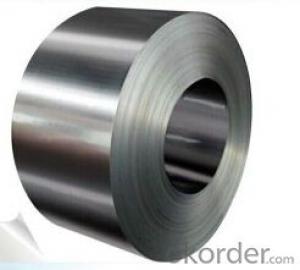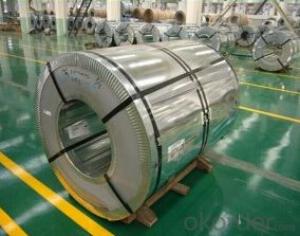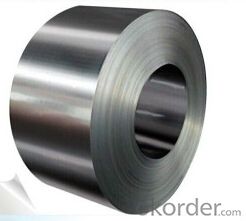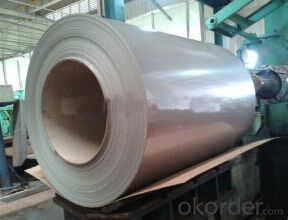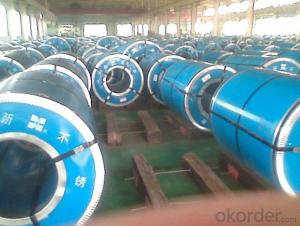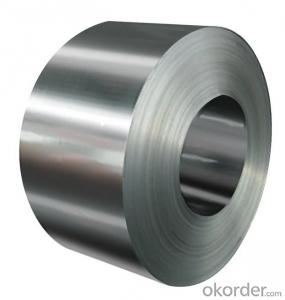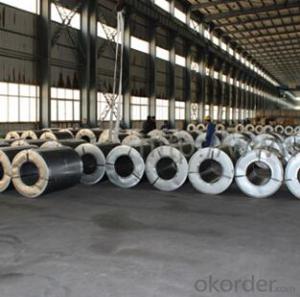304 Cold Rolled Stainless Steel for Buliding Material
- Loading Port:
- Shanghai
- Payment Terms:
- TT OR LC
- Min Order Qty:
- 30 m.t.
- Supply Capability:
- 10000 m.t./month
OKorder Service Pledge
OKorder Financial Service
You Might Also Like
Product Details
Basic Info.
Model NO.:304/304L/316/316L/321/409/409L/410/410S/430
Type:Stainless Steel Strips
Shape:Coil
Grade:300 Series
Certification:ISO, SGS
Perforated:Not Perforated
Standard:ASTM, AISI, GB, JIS, DIN, EN
Technique:Cold Rolled
Surface Treatment:Bright
Surface:2D,2e,2b,2bb,Sb,No.4,Ba,Hl,6k,7k,8k
Width:1000mm/1219mm/1250mm/1500mm/1524mm/1829mm/2000mm
Thinckness:0.3mm to 6mm
Edge:Silt/Mill Edge
Export Markets:Global
Product Description
The detail specification of cold rolled stainless steel coils are as below:
| Grade: | 201/202/301/304/304L/316/316L/317L/321/409/409L/410/410S/430/439 |
| Standard: | ASTM,AISI,JIS,EN,DIN,GB |
| Surface: | 2D,2E,2B,2BB,SB,NO.4,BA,HL,6K,7K,8K |
| Width: | 1000mm/1219mm/1250mm/1500mm/1524mm/1829mm/2000mm |
| Thickness: | 0.3mm to 6mm |
| Edge: | Slit/Mill Edge |
| Origin: | TISCO,POSCO,LISCO,JISCO,BAOSTEEL,Baoxin,Eastern Special Steel and so on |
| Productivity: | 10000MT/Mont |
| MOQ: | 30mont |
| Payment Term: | TT,L/C at sight/, L/C 30,60,90,180 days,WEST UNION |
| Price Term: | FOB/CFR/CIF Ningbo,Shanghai,Tianjin,Shenzhen Port |
| Delivery: | 7-10 days after receive buyer's advance deposit or LC copy |
| Packaging: | Seaworthy Export Standard Package.Products are packed and labeled according to the regulations and customer's requests. Great care is taken to avoid any damage which might otherwise be caused during storage or transportation. In addition, clear labels are tagged on the outside of the packages for easy identification of the product I. D. and quality information. |
| Detail Application: | construction field;ship building industry;petroleum and chemical industries;war and electricity industries;food processing and medical industry; boiler heat exchanger; machinery and hardware industry |
Technical notes:
| Surface Finish Definition | Application | |
| NO.1 | The surface finished by heat treatment and pickling or processes corresponding there to after hot rolling. | Chemical tank, pipe. |
| 2D | Those finished, after cold rolling, by heat treatment, pickling or other equivalent treatment. | Construction Material, heat exchanger,exhaust pipe |
| 2B | Those finished, after cold rolling, by heat treatment, pickling or other equivalent treatment and lastly by cold rolling to given appropriate luster. | Medical equipment, Food industry, Construction material, Kitchen utensils. |
| BA | Those processed with bright heat treatment after cold rolling. | Kitchen utensils, Electric equipment, Building construction. |
| NO.3 | Those finished by polishing with No.100 to No.120 abrasives specified in JIS R6001. | Kitchen utensils, Building construction. |
| NO.4 | Those finished by polishing with No.150 to No.180 abrasives specified in JIS R6001. | Kitchen utensils, Building construction, Medical equipment. |
| HL | Those finished polishing so as to give continuous polishing streaks by using abrasive of suitable grain size. | Building Construction. |
| No.8 | A highly reflective finish obtained by polishing with successively finer abrasive and buffing extensively free of grit lines | Indoor decoration & Reflector, Hospital Equipment |
Our Advantages
All products are made of high-quality imported raw materials.
Excellent shipment after-sales service & Prompt
The Authorized agent of TISCO,JIISCO,the stainless steel distributor of BOSTEEL,ZPSS,LISCO and also can get the resources from all the stainless steel mills in China.
Have own processing and distribution center & can take the orders according to customers' requirements.
The transport in Hangzhou is very convenient & nearby Shanghai and Ningbo Port.
Our products are certified by ISO9001:2008 authentication quality systems.
Quick Response to Your Enquiry.
- Q: Steel is no doubt a better constructin material but it is only in practice in developed country.i would like that we should high lights the benifits and negatives of steel to make the steel more clear as a construction material.Hope some expert to address this topicMD
- Steel Structure considered as the most efficient and fast in completion of any project, specially the high rise buildings, also the logistics during construction is less complicated than the normal methods, Steel Structure has so many advantages vs the disadvantages, and highly recommended for commercial buildings
- Q: What are the different methods of engraving steel coils?
- There are several methods of engraving steel coils, including laser engraving, chemical etching, mechanical engraving, and electrochemical etching. Each method involves different techniques and tools to create precise and permanent markings on the surface of the steel coils.
- Q: I am working on a hydrogen generator, but the stainless steel I am using corrodes and turns the water brown. Can anyone tell me if there is stainless steel that does not corrode, and if so, what is it called and where can I get some.Thank you.
- Maybe okorder Hope this can help you.
- Q: Does anyone know how to make a steel helmet, or does anyone know where to direct me websites-wise? i've just started looking on the web for info, so when i get back here i might've already found some info, but more wouldn't hurt, especially if from people who are interested on the subject. i know nothing about metallurgy, nothing on the art of metal working etc... please help.
- The okorder (Artist Blacksmiths) or on the sites of the two organizations that reproduce old costumes and tools - one is called The Society for Creative Anachronism, not sure of the other. Search terms to use might be hammering a helmet and forging medieval armor
- Q: How are steel coils handled during transportation to prevent damage?
- Steel coils are typically handled with extreme care during transportation to prevent damage. They are secured tightly using steel strapping or bands to prevent any movement or shifting during transit. Additionally, protective packaging materials, such as wooden or steel crates, are often used to provide extra cushioning and stability. Specialized equipment, such as forklifts or cranes, are used to lift and load the coils onto trucks or containers, ensuring safe and secure transportation.
- Q: Aluminum alloy rolling doors and color steel shutter door that good
- Hello, the shutter door material mainly galvanized steel plate, color steel plate, aluminum alloy, stainless steel, PVC soft board, PVC soft door curtain.
- Q: I have two guitars, a nylon stringed classical, and a steel stringed acoustic, I find the nylon strings easier to play, but doesn't have as good of sound as the steel stringed, and when I play with the steel strings, it really hurts my fingers, and if I play just a little bit, it feels like the high e string is going to cut my finger. Are the strings too high? What can I do to make the steel strings easier to play?
- find an online tuner and tune the strings to the tuning you want. trust me, guitar hurts your fingers after a while. but your skin gets used to it's, it's what ever.
- Q: What is the market demand for steel coils?
- The market demand for steel coils is influenced by various factors such as economic growth, construction and infrastructure projects, automotive manufacturing, and consumer goods production. It fluctuates based on these industry trends and overall market conditions. Currently, the market demand for steel coils is significant due to increased construction activities, infrastructure development, and manufacturing needs globally. However, it is important to note that market demand can vary regionally and may be subject to short-term fluctuations based on specific economic and industrial factors.
- Q: How do steel coil manufacturers contribute to local economies?
- Steel coil manufacturers contribute to local economies in several ways. Firstly, they create employment opportunities by hiring a significant number of workers, thereby reducing unemployment rates and improving the standard of living in the community. These jobs often include a range of skill levels, from entry-level positions to highly specialized roles, providing a diverse range of employment options for locals. Additionally, steel coil manufacturers contribute to the local economy through their supply chain. They typically rely on local suppliers for raw materials, transportation services, and various support services, fostering business relationships and boosting the local economy. This leads to increased revenue for these suppliers and stimulates economic growth in the region. Moreover, the presence of steel coil manufacturers can attract other businesses to the area, such as logistics companies, distributors, and machine shops, which further enhances the local economy. This expansion of the industrial sector can result in a multiplier effect, generating additional job opportunities and attracting investment from outside the community. Lastly, steel coil manufacturers often engage in corporate social responsibility initiatives, such as supporting local charities, sponsoring community events, or investing in infrastructure development. These contributions not only have a positive social impact but also contribute to the overall economic development and well-being of the local community. In summary, steel coil manufacturers play a crucial role in local economies by creating jobs, stimulating the supply chain, attracting businesses, and investing in community development, all of which contribute to the growth and prosperity of the region.
- Q: What are the weight ranges of steel coils?
- The weight ranges of steel coils can vary depending on their dimensions and intended use. Generally, steel coils can range from a few hundred pounds to several tons in weight. For example, hot-rolled steel coils typically weigh between 10 and 25 tons, while cold-rolled steel coils can weigh anywhere from a few hundred pounds to 20 tons. The weight of steel coils can also vary based on factors such as the thickness and width of the coil, as well as the grade and type of steel being used. Ultimately, the weight range of steel coils is determined by the specific requirements of the industry and application in which they are being used.
Send your message to us
304 Cold Rolled Stainless Steel for Buliding Material
- Loading Port:
- Shanghai
- Payment Terms:
- TT OR LC
- Min Order Qty:
- 30 m.t.
- Supply Capability:
- 10000 m.t./month
OKorder Service Pledge
OKorder Financial Service
Similar products
Hot products
Hot Searches
Related keywords
